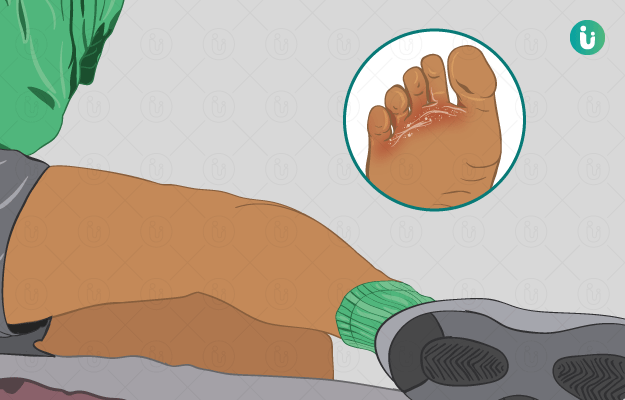What is athlete’s foot?
Athlete’s foot is a fungal infection of the foot, commonly affecting the skin between the toes. It is so called because of its common occurrence in athletes. The fungus responsible for this infection is tinea, hence, the disease is also called tinea pedis.
What are its main signs and symptoms?
- A person suffering from athlete’s foot will have itching and burning sensation between the toes.
- The skin becomes red with a dry, scaly appearance.
- Rarely there may be blisters or ulcers on the feet, with slight bleeding.
- The nails appear crumbly and brittle.
- The infection spreads to the hands and other parts if the affected area is repeatedly touched.
What are the main causes?
- Infection caused by fungi like Microsporum is responsible for athlete’s foot. It is an infectious disease and can spread by touch or through infected socks, carpets, etc.
- Rarely, bacteria and psoriasis can also mimic this infection.
- Moist, unclean feet or unkempt nails make a person more susceptible to this infection.
- Walking barefoot in public places and sharing socks are some risk factors associated with athlete’s foot. Shared office spaces, gyms and swimming pools are some areas where the infection can spread.
- Patients suffering from diabetes or immunocompromised conditions like AIDS are more prone to such infections.
- Excessive sweating is also a contributory factor for this disease.
How is it diagnosed and treated?
- A physical examination of the foot helps the doctor diagnose the disease. At times, if the cause is uncertain, a skin biopsy of the foot is carried out for confirmation.
- The treatment of this condition includes:
- Anti-fungal medications, which are available over the counter and as prescription medicines. These medicines may be prescribed for up to 4 weeks, depending on the severity of the disease.
- If the causative organism is bacteria, anti-bacterial medicines are prescribed.
- It is important to keep the feet clean and protected in public places. The infection tends to recur if the fungus is not completely eliminated.
Self-care
- Avoid wearing damp or dirty socks and shoes.
- Clean your feet after coming indoors, especially from public places.
- Do not share towels, napkins, socks etc.
- Wear well-covered shoes or sandals to protect your feet.
(Get online doctor consultation for any health issue)

 Doctors for Athlete's Foot
Doctors for Athlete's Foot  OTC Medicines for Athlete's Foot
OTC Medicines for Athlete's Foot


















